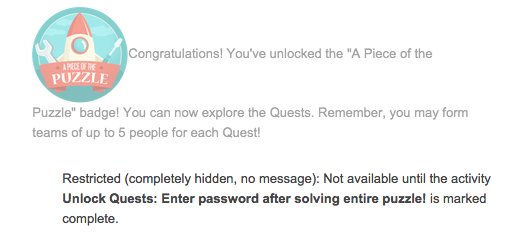Background and Reflection
In the fall of 2014, I taught an Introduction to Science, Technology, and Society course (see syllabus) that incorporated gamification as a way to teach critical making as a kinesthetic practice to help elucidate the scientific and technologic theory in our textbook.
The experimental and iterative nature of critical making blended well with the emphasis on learning from failure and leveling up that is enabled by gamification.
The unique structure of this course provided students with a great deal of liberty regarding which types of assignments they chose to pursue. Replacing the grading system was an XP accumulation process with the ability to level up. Points were strictly cumulative, meaning if students did not perform well on a particular task, they could either re-do it or choose another task without a negative impact on their final grade.
Many students enjoyed and appreciated this freedom, but others were hesitant and uncertain about how to precede, largely because they had not previously had this degree of freedom and self-direction in the classroom. I worked closely with students and developed a worksheet that helped them create a plan to earn enough XP to translate to the final grade they planned to achieve in the course. Despite this coaching, a few students were never able to warm up to the idea of a cumulative grading system where they could choose which projects to complete. Overall, I believe the course was a success. The results of the quests, detailed below, were outstanding. Students created:
- a surface-free mouse
- a robotic hand prototype
- an augmented reality musical experience
- 3D printed phone cases that hold headphones
- and an early prototype for a mind-controlled car
… all while gaining a deeper critical understanding of the development of science and technology as a deeply social process.
Gamification: Story
The course kicked off with a puzzle to get the story going. This story featured a fictional discovery during the construction of our campus’ new Hunt Library. While moving books from D.H. Hill Library to the new book bot at Hunt Library, librarians discovered an mysterious additional passage in an ancient copy of Aristotle’s De Anima. However, the passage seemed to be encoded.
The class then worked together using an online forum to solve the puzzle (linked here) that unlocked the course, its quests, and their first badge.
Gamification: Badges
By completing certain activities in the course, students were automatically awarded badges through the Moodle platform that hosted the online portion of our course. For example, when students solved the first puzzle, they were awarded a badge:
As you can read above, the above badge was only unlocked for a student once they solved the initial puzzle.
Other badges could be earned for things like tweeting the work they were doing (social tie-in) or completing a major quest. Though there was no further reward than the badge itself, many students found this a motivational aspect of the course. For example, although only one group member needed to submit project files, the badge was only unlocked for the account that submitted the file. For this reason, many groups elected to have every member submit the files separately, so they could all earn badges.
Gamification: Quests and Critical Making
As part of this introductory course, students competed as groups on at least one gamified quest to invent new technologies using tools such as micro-controllers, 3D printing, data visualization, and augmented reality. The quest was divided into four stages, reflecting North Carolina State University’s emphasis that students “Think and Do”:
- Research: In this stage they researched their selected critical making tool and reported back to the group with examples of how it has been used so far.
- Make: After learning about the tools individually, they worked together in small groups to become more familiar with the technology as they followed tutorials to re-create a project that has already been done.
- “Think” phase: The students brainstormed a new or innovative way to use the technology. They submitted a plan that is similar to a patent application, that showed how their invention is different from other similar technologies, and created drawings, designs, and descriptions of their planned project, which went through an iterative peer and instructor review process.
- “Do” phase: Students worked together to bring their invention to life using the critical making tools. They created the invention itself, and a multi-modal project that explained the new invention and how it connected to the theories that they learned in class.
Gamification: Social tie-in
An important aspect of gamification is being able to share achievements with friends, and for that reason, I asked students to share the work on their quest socially through Twitter or Instagram. This worked really for several reasons. First, it connected with North Carolina State University’s Instagram contest, which asked students and faculty to submit pictures and video that reflected the motto “Think and Do.” As part of this contest, one of my students won a GoPro camera for the documentation of their work on the quest!
Finally, sharing this work afforded the opportunity to create a Storify project that archived the amazing work that students were doing. You can get an overview of the course through that Storify below. It begins with my sharing the final results of the course, and then moves on in the following pages to the students’ sharing of their work in progress:

